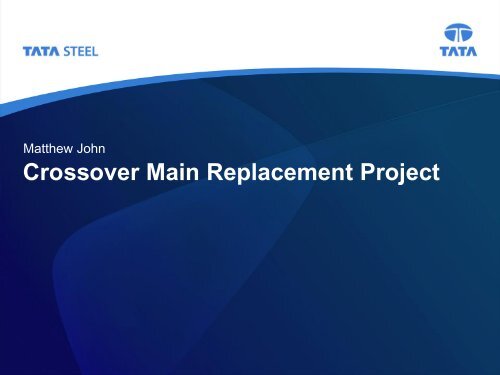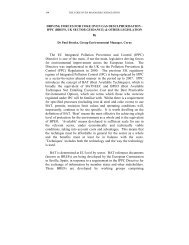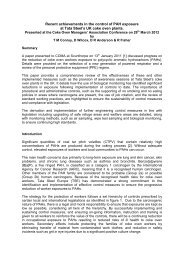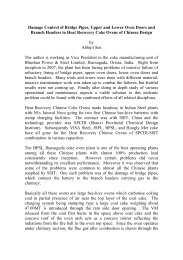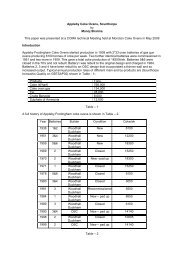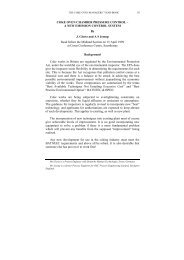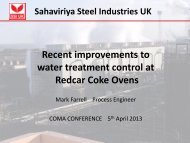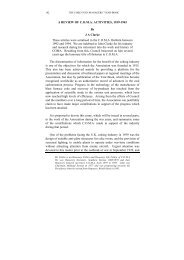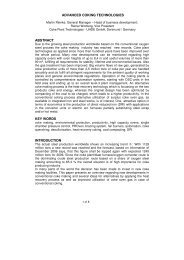Crossover Main Replacement - Coke Oven Managers Association
Crossover Main Replacement - Coke Oven Managers Association
Crossover Main Replacement - Coke Oven Managers Association
You also want an ePaper? Increase the reach of your titles
YUMPU automatically turns print PDFs into web optimized ePapers that Google loves.
Matthew John<br />
<strong>Crossover</strong> <strong>Main</strong> <strong>Replacement</strong> Project
Introduction<br />
• Morfa <strong>Coke</strong> Making plant is an Otto Simon Carves’ Twin<br />
Flue Underjet Compound design with twin collector<br />
mains.<br />
• The <strong>Oven</strong>s were comissioned in 1981 and consists of 84<br />
ovens (2 batteries of 42 ovens).<br />
• As part of the coke making process, volatile gases<br />
released from the coal during the carbonisation process<br />
are exhausted from the ovens to a By-Product plant, via a<br />
gas recovery pipe work system referred to as “crossover<br />
mains” There are four crossover mains in total, two per<br />
battery.<br />
2
Introduction<br />
After 33 years of uninterrupted service, each crossover has<br />
typically seen in the region of 1.45 billion m 3 of coke oven gas.<br />
The system has already surpassed its original design life by<br />
some 8 years and the pipe work was in poor condition.<br />
3
Introduction<br />
Due to the poor condition of the pipe work and the losses of<br />
containment, we were faced with three options.<br />
1. Repair the current pipe work by “over plating”.<br />
2. Remove the <strong>Coke</strong> side Gas Collecting <strong>Main</strong> and<br />
“<strong>Crossover</strong> mains” altogether and operate the plant on a<br />
single Gas Collecting <strong>Main</strong>.<br />
3. Remove the <strong>Crossover</strong> mains and replace with new.<br />
4
Introduction<br />
The first two options were not viable, firstly each of the<br />
crossover mains had previously been “over-plated”, and this<br />
would only prove to be a short-term repair.<br />
Secondly even though it was possible to operate the plant on<br />
a single Gas Collecting <strong>Main</strong> the operating tolerances were<br />
too fine, due to the size of our oven design and size of out<br />
Ascension pipes.<br />
Stopping the coke making process to replace these crossover<br />
mains was not an option, so plans were put together to<br />
change all four mains on a “live gas” system.<br />
This is believed to be a first for Tata Steel Europe if not<br />
worldwide.<br />
5
Planning Phase<br />
The planning phase was key to the success of this project.<br />
A project team was formed which was collaboration between<br />
both Process and Engineering personnel from the <strong>Coke</strong> oven<br />
department, Process Safety personnel and personnel from<br />
the Project department.<br />
A master schedule was produced and a weekly status review<br />
plan was used to provide an easy to read breakdown of the<br />
imminent tasks.<br />
6
Planning Phase<br />
Health and Safety<br />
Safety was the main priority of this project and to ensure<br />
there weren’t any accidents, there were a number of safety<br />
measures taken.<br />
The project was carried out in accordance with CDM<br />
regulations and F10 notification was issued to the HSE.<br />
The project team were nominated as both CDM Co-ordinator<br />
and Principal Contractor.<br />
7
Planning Phase<br />
Health and Safety<br />
Due to the hazards involved with this project a huge amount<br />
of time and effort was invested in Hazard Identification and<br />
Process Hazard Analysis.<br />
Event trees were constructed to provide good clear<br />
visualisation of the events requiring mitigation, this helped to<br />
develop a comprehensive Process Hazard Analysis.<br />
8
Planning Phase<br />
Assembly Drawings<br />
An assembly drawing was constructed covering the entire<br />
scope of the installation including over-plating, temporary<br />
platforms and the interconnection pipe work<br />
9
Planning Phase<br />
‘Mock-up’ trial<br />
Another crucial part of the planning phase was the<br />
construction of a ‘mock-up’, simulating the blanking spade<br />
insertion and removal process.<br />
The mock-up included:<br />
•The blanking spade<br />
•Clamping ring concept<br />
•Jacking steel work<br />
•Guide cradle<br />
•and protective curtain.<br />
10
Preparation Phase<br />
Jacking Steelwork & Over plating<br />
Before any work could be started a substantial amount of<br />
preparation was required.<br />
Large areas of the collector mains required over plating to<br />
ensure there was enough “mechanical strength” to carry out<br />
the replacement task.<br />
Additional steelwork was erected to provide “jacking points”<br />
for splitting the flanges with hydraulic jacks.<br />
Pressure control and purging operations<br />
Nitrogen purge points and re-circulating gas stabbings were “hottapped”<br />
into the crossover mains to facilitate pressure control and<br />
purging operations.<br />
11
Preparation Phase<br />
Ground preparation of surrounding areas<br />
Calculations made during the planning phase of the project<br />
considered the weight of each crossover main assuming they<br />
were totally blocked with heavy tar deposits.<br />
“Gas flow” testing was also conducted as part of the planning<br />
phase; this indicated that each of the crossover mains was<br />
substantially blocked.<br />
The weight of each main was calculated to be approximately<br />
40 tonnes, which resulted in the requirement for an 800T<br />
crane.<br />
Ground surveys were performed in the two crane location<br />
areas and the ground was prepared in readiness for the<br />
arrival of the crane.<br />
12
Preparation Phase<br />
Spreader beam<br />
Due to the visibly poor condition of the existing crossover<br />
mains, there was real concern that the horizontal section of<br />
the main could collapse under it’s own weight during the<br />
removal process.<br />
Therefore a bespoke “spreader beam” was designed and<br />
manufactured, that supported the pipe at one-metre pitches to<br />
mitigate this problem.<br />
13
Preparation Phase<br />
<strong>Coke</strong> “Dump Wharf”<br />
The crane location for the work carried out on number two<br />
battery, prevented the use of the existing <strong>Coke</strong> “dump wharf”.<br />
This was recognised during the planning phase and a new<br />
“emergency coke dump wharf” was constructed.<br />
14
Preparation Phase<br />
Interconnecting pipe work<br />
Preparation had to be made for each battery to operate on a<br />
single crossover main while one was being replaced.<br />
This was achieved by the installation of interconnection pipe<br />
work and valves, which enabled the gas make to be re-routed<br />
to the adjacent Gas collecting main.<br />
A pipe work arrangement was “hot tapped” into the ram side<br />
gas collector main and a duplex arrangement was “hot<br />
tapped” into the coke side gas collector main.<br />
15
Preparation Phase<br />
Welding inspection & Pressure testing<br />
All the new pipe work, including the service pipe work was<br />
manufactured and tested at Fairwood Fabrications Ltd<br />
workshop.<br />
Before leaving the workshop every weld was 100% MPI<br />
tested and each pipe section pressure tested with<br />
compressed air to one and a half times the maximum working<br />
pressure.<br />
A quality assurance (QA) file complied throughout the<br />
manufacturing process was produced and formed part of the<br />
Health and Safety file.<br />
16
Preparation Phase<br />
Expansion Joint<br />
The only design change from the original crossover design was the<br />
inclusion of an expansion bellows.<br />
This was to allow for any thermal expansion likely to have taken place<br />
when the new crossover at ambient temperature is connected to the<br />
working gas system with temperatures around 80° C.<br />
17
<strong>Crossover</strong> <strong>Main</strong> <strong>Replacement</strong><br />
Isolating the first <strong>Crossover</strong> main<br />
Insertion of the first blanking plate was the first real test of all<br />
the months of preparation and planning.<br />
For each crossover the Ram side leg was blanked off first<br />
followed by the <strong>Coke</strong> side.<br />
As an output from the Management of change and risk<br />
assessment exercises, a comprehensive checklist was<br />
written to ensure all tasks were listed and signed off when<br />
completed.<br />
A crane and hydraulic jacks were used to split the flanges.<br />
18
<strong>Crossover</strong> <strong>Main</strong> <strong>Replacement</strong><br />
Isolating the first <strong>Crossover</strong> main<br />
The most critical part of this process was the control of the<br />
gas pressure while splitting the flanges.<br />
To ensure the precise control required for this task, the<br />
system was controlled manually using pressure gauges and<br />
vent pipes to provide a visual indication to the controller.<br />
While inserting the blanking plate the sight of coke oven gas<br />
emerging from the split flange was a good indication that<br />
there was a slight positive gas pressure preventing air ingress<br />
and the threat of explosion.<br />
19
<strong>Crossover</strong> <strong>Main</strong> <strong>Replacement</strong><br />
Isolating the first <strong>Crossover</strong> main<br />
Guided slots at the front edge of the blanking plate located<br />
around the few loosened flange bolts at the rear of the flange;<br />
to facilitate bolthole alignment.<br />
When all the new flange bolts were loosely fitted, the<br />
crossover main leg supported by the crane was lowered until<br />
the flanges fitted onto the new gasket.<br />
20
<strong>Crossover</strong> <strong>Main</strong> <strong>Replacement</strong><br />
Removal of “Bend Section”<br />
The bend section of the crossover was disconnected form the<br />
horizontal section to prevent slewing as the horizontal section<br />
was lifted out.<br />
An 80 tonne crane set-up on the Ram track side of the<br />
Battery was used to execute the lift.<br />
After disconnection of the flanges and breaking up of the<br />
heavy tar deposit at the flange, the bend was lowered to the<br />
floor.<br />
21
<strong>Crossover</strong> <strong>Main</strong> <strong>Replacement</strong><br />
Removal of “Bend Section”<br />
22
<strong>Crossover</strong> <strong>Main</strong> <strong>Replacement</strong><br />
Horizontal Section Removal<br />
After disconnection of all service pipe work and the flanges<br />
connecting the horizontal section to the verticals, the fully<br />
supported the horizontal section was ready for removal.<br />
23
<strong>Crossover</strong> <strong>Main</strong> <strong>Replacement</strong><br />
Horizontal Section Removal<br />
When the pipe work was lowered to the floor level, it was<br />
clear to see it’s poor condition and the necessity to support<br />
the pipe at one-metre intervals.<br />
Also as the “gas flow” tests performed prior to the work<br />
starting indicated, the pipe cross sectional area was<br />
substantially reduced by deposits effecting gas flow through<br />
the pipe.<br />
24
Installing the new <strong>Crossover</strong> <strong>Main</strong>s<br />
Installation of the new horizontal section<br />
Prior to the installation of each new horizontal section all the<br />
support steelwork was upgraded to ensure good mechanical<br />
integrity and extend the life expectancy.<br />
The installation process was simply the reverse of the<br />
removal process.<br />
The new vertical legs were lifted and secured into place, and<br />
then the horizontal sections complete with all new service<br />
pipe work and expansion joint was lifted into place.<br />
<strong>Main</strong>taining good visual and radio contact with the crane<br />
operator was essential throughout the lift.<br />
25
Installing the new <strong>Crossover</strong> <strong>Main</strong>s<br />
Installation of the new horizontal section<br />
Scaffolding towers erected on either end of the crossover<br />
proved a safe working area for the installation team to<br />
carefully guide the new pipe into place and install the new<br />
gaskets.<br />
26
Installing the new <strong>Crossover</strong> <strong>Main</strong>s<br />
Installation of Bend Section<br />
The final section to be fitted is the bend.<br />
The bend section was cut to suit, allowing for the difference in<br />
the new installation fitting to the existing pipe work that is still<br />
operational and carrying hot gas.<br />
The bend was measured and tacked on site then removed<br />
backed to a workshop for completion.<br />
27
Installing the new <strong>Crossover</strong> <strong>Main</strong>s<br />
Removing the Blanking plates<br />
With the installation of the new pipe work complete the next<br />
phase of the installation was the removal of the spade that<br />
was preventing the gas flow over the new pipe.<br />
Again the pressure control was critical to the success of this<br />
phase, so to ensure the precise control required for this task,<br />
the system was controlled manually using pressure gauges<br />
and vent pipes to provide a visual indication to the controller.<br />
The coke side spade was removed first followed by the ram<br />
side.<br />
28
Installing the new <strong>Crossover</strong> <strong>Main</strong>s<br />
Removing the Blanking plates<br />
Again the 800 tonne crane was used to split the flanges via<br />
the bespoke spreader beam.<br />
Slowly the spade was removed and the gas pressure was<br />
adjusted as required.<br />
When the blanking spade was fully removed, the bolts were<br />
replaced and the main was lowered back onto the new gasket<br />
and the joint was secured.<br />
At this point coke oven gas was flowing through the new<br />
crossover pipe work and the new main was “live”.<br />
29
Summary<br />
The project took 40 weeks to complete from start to finish.<br />
Thousands of man-hours were utilised.<br />
Four new crossover mains were successfully installed.<br />
The project was completed on time, within budget and without<br />
any accidents.<br />
30


